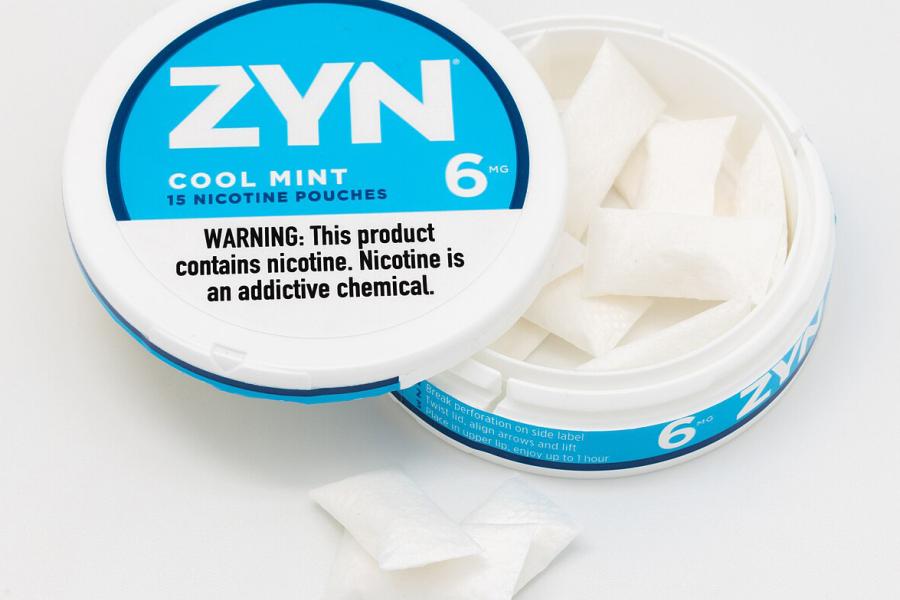In an impressive showing of alliteration, Sen. Chuck Schumer recently described the trending nicotine product Zyn as a "pouch packed with problems" while delivering a warning to parents and calling for a federal investigation into the brand's marketing tactics and health effects.

Image caption: Tory Spindle
You may not have heard of Zyn or its peers—brands like On!, VELO, and Rogue—but sales of these smoke-free, often tobacco-free nicotine pouches increased from 126 million units between August and December 2019 to more than 808 million between January and March 2022. In 2022, tobacco conglomerate Philip Morris International bet big on Zyn, acquiring its parent company Swedish Match as part of its push into smokeless products. Zyn and other oral nicotine products are expected to bring $2 billion in U.S. revenue this year. And on social media sites like TikTok, the product is popular among so-called "zynfluencers" who document their use daily, tucking a pouch discreetly into their upper lip before school, work, or gym sessions, in the middle of sports games, while playing video games, and conducting taste-tests with friends.
Sold in 3 mg and 6 mg doses, the pouches deliver nicotine directly into the bloodstream through the mouth's membrane lining, rather than through the lungs. In many ways, the pouches are safer than other nicotine products on the market because they do not use tobacco leaves and therefore have fewer carcinogens. But they are not risk-free: They can be addictive and cause cardiovascular issues, gum damage, and nausea. Experts also express concern about how easy they are to conceal and the variety of flavors offered—peppermint, coffee, and citrus, to name a few—that make them appealing to kids.
These brands "really highlight flavors, and all of the pouches have catchy one syllable names. It almost seems like they're trying to make them come off more like a gum rather than an actual nicotine product," says Tory Spindle, an associate professor in the Department of Psychiatry and Behavioral Sciences at the Johns Hopkins School of Medicine.
"Something that concerns us are claims about the product being discreet," adds Meghan Moran, an associate professor in the Department of Health, Behavior, and Society at the Johns Hopkins Bloomberg School of Public Health who is working with Spindle to research nicotine pouches. "We are worried that this could be appealing to young people—and we are currently conducting a study to find out if this is the case."
The Hub caught up with Spindle to learn more about this emerging form of nicotine.
What initially caught your attention about nicotine pouches as a researcher?
I saw a lot of parallels between e-cigarettes and nicotine pouches. They seem like they have a lot of flavors that would make them appealing to [youth], but the harm with youth using nicotine products is there are unknowns with their long-term effects, and it also could lead to other product use. But on the other hand, they're unquestionably safer than existing tobacco products.
And so that's where the public health dilemma is: How do we make them accessible to cigarette smokers or oral tobacco users—people who dip or chew—so they can use a less harmful product, while not also inadvertently making a bunch of new people addicted to nicotine who otherwise would have never tried products like that?
When you say we don't yet know the long-term effects of these products, are you referring to nicotine on its own, sans tobacco?
The pouches have flavorings and other constituents in there that haven't historically been in nicotine products before. So while they don't have the conventional carcinogens we know are present at high levels in tobacco, we don't know what some of the other things are going to do.
The other thing, too, is that when people are using any drug when they're still in adolescence, their brain is still developing. Use of nicotine or other addictive things can impact your brain development in ways that are hard to predict.
So what is known about nicotine pouch safety?
We do know from my research that they can cause acute adverse events. Some people report nausea. Some people have reported developing mouth lesions from using them too much. But it's undeniable that they have less conventional carcinogens compared to oral tobacco products, like chewing tobacco and whatnot.
I've also seen it promoted as a stimulant, something that improves mental clarity. Is there any science behind that?
There [are studies showing] that nicotine is a stimulant and can boost cognitive functioning. There is some truth to that. But do you want young people who otherwise wouldn't use a tobacco product to be using it for that purpose over another stimulant with less abuse potential and issues—caffeine, for example?
Are there major differences among the various brands on the market?
Not all of them are actually tobacco free. Some of them contain tobacco-derived nicotine. There are trace components of tobacco-specific nitrosamines and things that are harmful, but it's still much, much lower than chewing tobacco, for example. Then there are other pouches that contain synthetically made nicotine, which is made in the lab and is not derived from tobacco. I don't know if it's always apparent from the label whether it's synthetic or not, but that's a nuance that we've seen in our research.
Posted in Health, Voices+Opinion
Tagged psychiatry, social media, behavioral science, e-cigarettes, vaping








